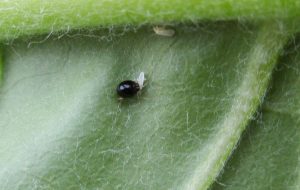
Hello! My name is Amara Dunn, and I am excited to have joined the New York State Integrated Pest Management (NYSIPM) program as the biocontrol specialist. Prior to starting this position, I studied vegetable diseases at Cornell University and taught in the Biology Department at Hobart and William Smith Colleges. I enjoy finding new ways to manage pests and helping others to manage them more effectively.
What is biocontrol?
Definitions of biological control (biocontrol, for short) vary, but biocontrol is often broadly defined as:
using natural enemies to reduce or maintain populations of pest organisms at sufficiently low levels.
Either the pest or its natural enemy might be a vertebrate (e.g., rodents), an invertebrate (e.g., insects, ticks, slugs), or a microorganism (e.g., fungi or bacteria). Aphids and ladybugs are an example you might be familiar with. Ladybug larvae eat the aphids that might otherwise damage plants.
But biocontrol isn’t limited to releasing beneficial insects like ladybugs. Some bacteria and fungi produce compounds that are toxic to pests, including insects, bacteria and fungi. Others can boost the health of plants and animals. Some nematodes (microscopic worms) invade and kill grubs that live in the soil.
Often natural enemies of a pest are already nearby (e.g., bats that eat insects or birds of prey that eat rodents). By improving their habitat, we can also improve pest control. Finally, many insects use their sense of smell to find mates. By using these scents — “pheromones” — to trap or confuse pest insects, the pest’s biology can be used for its own control.
If you’d like to learn more about biocontrol, a lot of information is available through a website created by Dr. Tony Shelton (Professor of Entomology, Cornell University): Biological Control: A Guide to Natural Enemies in North America.

Why biocontrol?
Biocontrol can be an important part of an integrated pest management strategy. For example, biocontrol organisms that support plant health can make them less susceptible to the pests that damage them (prevention). If something needs to be applied to reduce pest populations (or keep them low), biocontrol products tend to be less harmful to other critters or people than chemical pesticides (choosing a pest management strategy with low environmental impact).
My goal is to help the people of New York – householders, people who work in schools and businesses, and farmers – understand when and how to use biocontrol as part of a successful integrated pest management strategy. If you have questions, you can email me at arc55@cornell.edu, or you can call my office at (315)787-2206. And soon I’ll launch a blog to provide additional information about biocontrol and its use in New York.